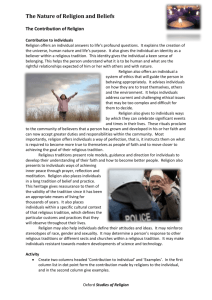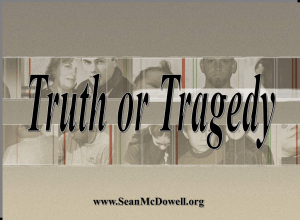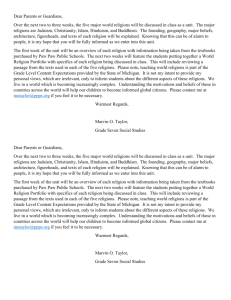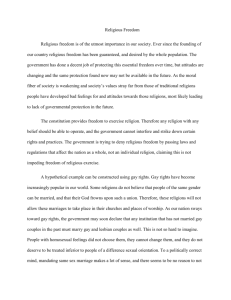File - Unitarian Universalist Church of Tullahoma
advertisement
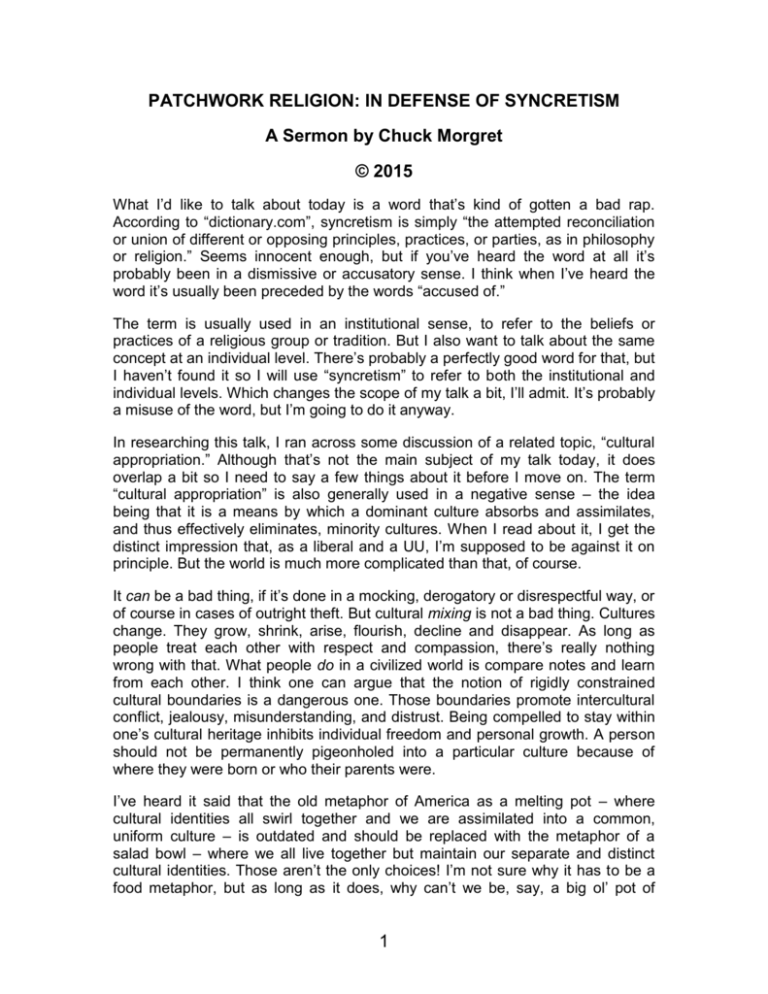
PATCHWORK RELIGION: IN DEFENSE OF SYNCRETISM A Sermon by Chuck Morgret © 2015 What I’d like to talk about today is a word that’s kind of gotten a bad rap. According to “dictionary.com”, syncretism is simply “the attempted reconciliation or union of different or opposing principles, practices, or parties, as in philosophy or religion.” Seems innocent enough, but if you’ve heard the word at all it’s probably been in a dismissive or accusatory sense. I think when I’ve heard the word it’s usually been preceded by the words “accused of.” The term is usually used in an institutional sense, to refer to the beliefs or practices of a religious group or tradition. But I also want to talk about the same concept at an individual level. There’s probably a perfectly good word for that, but I haven’t found it so I will use “syncretism” to refer to both the institutional and individual levels. Which changes the scope of my talk a bit, I’ll admit. It’s probably a misuse of the word, but I’m going to do it anyway. In researching this talk, I ran across some discussion of a related topic, “cultural appropriation.” Although that’s not the main subject of my talk today, it does overlap a bit so I need to say a few things about it before I move on. The term “cultural appropriation” is also generally used in a negative sense – the idea being that it is a means by which a dominant culture absorbs and assimilates, and thus effectively eliminates, minority cultures. When I read about it, I get the distinct impression that, as a liberal and a UU, I’m supposed to be against it on principle. But the world is much more complicated than that, of course. It can be a bad thing, if it’s done in a mocking, derogatory or disrespectful way, or of course in cases of outright theft. But cultural mixing is not a bad thing. Cultures change. They grow, shrink, arise, flourish, decline and disappear. As long as people treat each other with respect and compassion, there’s really nothing wrong with that. What people do in a civilized world is compare notes and learn from each other. I think one can argue that the notion of rigidly constrained cultural boundaries is a dangerous one. Those boundaries promote intercultural conflict, jealousy, misunderstanding, and distrust. Being compelled to stay within one’s cultural heritage inhibits individual freedom and personal growth. A person should not be permanently pigeonholed into a particular culture because of where they were born or who their parents were. I’ve heard it said that the old metaphor of America as a melting pot – where cultural identities all swirl together and we are assimilated into a common, uniform culture – is outdated and should be replaced with the metaphor of a salad bowl – where we all live together but maintain our separate and distinct cultural identities. Those aren’t the only choices! I’m not sure why it has to be a food metaphor, but as long as it does, why can’t we be, say, a big ol’ pot of 1 jambalaya, where the individual ingredients keep their distinct identities but they all flavor each other, and all those flavors combine into something much greater than the sum of the parts? DANGERS OF RIGID BELIEF SYSTEMS And now I’ll try to get back on topic… Rigid religious boundaries, like rigid cultural boundaries, are a very dangerous thing. Sadly, scanning the world news on just about any given day will support that observation. Many religious leaders fear dilution of the purity of their faith – they believe, and insist that their followers believe, that there is one right way to believe and live, and only they have it! They fear that any tempering of that message will lead to attrition of their membership as followers are tempted away from the true path. Interestingly, this seems to be true even within decentralized faiths. Their followers go along with this for complex reasons. There is a human tendency to gravitate toward “hero worship”. That is, we make the leap from revering a leader or teacher because their words ring true and resonate with us to blindly accepting anything they say because we revere them. We elevate them to godhood. When we do that – when we stop bringing a healthy dose of skepticism to bear on what we are asked to believe – we are in danger of being led astray. People want certainty and clarity in an uncertain and ambiguous world, and those who appear to offer it have a strong appeal. There’s also a perceived gain in status that comes with belonging to an exclusive group, even if that status is gained at the expense of those who don’t belong. Rigid, exclusive religious belief systems lead their adherents to see the world from an “us versus them” perspective, with only three possible ultimate outcomes for the “us” involved: one, we convert everyone to our way – whether it’s by force or through our superior debating skills doesn’t really matter; two, we eliminate them; or three, they eliminate us. Finding common ground would require us to compromise our beliefs – and maybe even think – and we just can’t allow that! This is, of course, a recipe for never-ending strife and hatred, punctuated by outand-out warfare. Insistence on adherence to unbending belief systems also stifles creativity and – as history clearly shows – scientific progress. One observation I came away from reading Jared Diamond’s “Guns, Germs and Steel” with was that, historically, organized religion has really had little overall effect on the progress of civilization – except in those cases where it kept the brakes on, by making specific advances taboo. Here’s a quote from the current Dalai Lama: “If scientific analysis were conclusively to demonstrate certain claims in Buddhism to be false, then we must accept the findings of science and abandon those claims.” How refreshing it would be if all religious leaders felt that way! 2 If there really is one shining way that is the only path to salvation, we’re all in big trouble, because I don’t see anything to indicate that anybody has stumbled across it yet. Humans aren’t perfect, and our beliefs need to grow and evolve right along with us. Each of us can assert that we have found a path that works for us, if that’s the case, but we need to be humble enough to realize that that doesn’t make it the only valid path, and that even we might need a course correction now and then. NEARLY ALL RELIGIONS ARE SYNCRETIC As I was putting together some examples of religions that could be characterized as syncretic, I came to the realization that nearly all religions are syncretic, in one way or another. Genuinely new ideas arising from thin air are few and far between. From our earliest ancestors on, most religions have been derived from or built on earlier ones, and any time somebody combined beliefs from two or more sources, they were…you got it…committing syncretism. Actually, I count it as syncretism even if they only took beliefs from one existing source and grafted new beliefs onto them. That fits the definition, I think, because they were thus attempting to reconcile their new beliefs with the older ones. A few examples: I don’t claim to know much about the origins of Judaism, but old as it is I’ve gathered that it likely evolved from even older Babylonian and Canaanite religions. The various polytheistic religions of the ancient Greco-Roman world borrowed heavily from each other -- so much so that from our modern perspective we think of them as the same religions with different terminology. The later Greek and Roman “Mystery” religions – which were conceptually similar to Gnosticism – were grafted onto the existing polytheistic traditions. Why would they have done that instead of just creating something new? Presumably so as to attract followers from within those religions. Christianity is arguably syncretic in several senses. One, it of course grew out of Judaism. As to why it was important for early Christianity to be perceived as the culmination of Judaism rather than as a completely new religion – leading to a two-thousand-year love-hate relationship – I will skip the details, but if you’re interested I strongly recommend Bart Ehrman’s Teaching Company® course, “History of Early Christianity.” Two, there’s a highly debatable but entertaining view that Christianity represented an attempt to graft a Mystery religion onto Judaism – an attempt that went seriously awry. Three, Christian motifs such as the Virgin Birth and Resurrection show up in earlier religions – I’m not going to take sides on what that means today, but it certainly has a syncretic element. And four (speaking of cultural appropriation) one way Christianity spread was by co-opting pagan traditions and holidays whenever necessary. Hence we have bunnies and eggs somehow mixed up with celebrating the resurrection of Jesus, and his 3 birthday celebrated at the winter solstice, with decorated evergreens, Yule logs and various other customs somehow tied in. In the same sense that Christianity grew from Judaism, Islam grew out of the same Abrahamic tradition. It is my understanding that the Islamic view is that Mohammed’s teachings don’t replace Judeo-Christian teachings, they extend and complete them. In much the same sense, Mormonism is also built on a Christian foundation, with one more prophet – Joseph Smith in this case – added on. RELIGIONS AT THE FRINGES Every major religious tradition seems to have, or have had, outlying sects that push the boundaries and sometimes cross them. I want to give you a few examples of what I think of as “religions at the fringes”: Leaving aside whether Christianity itself was intended to be a Mystery religion, the early Christian Gnostics appear to have been trying to bridge the gap. Zen Buddhism was more or less what happened when Indian Buddhism met Chinese Taoism. Within Islam, we have Sufism, a mystical tradition that has some parallels with gnostic or Mystery religions. Whether Sufism is actually syncretic – that is, whether it was influenced by interaction with other religions – is apparently not clear. The Druze religion, which grew out of Shia Islam long ago, is a sort of Islamic version of Gnosticism that apparently borrows from other philosophies as well. (Coincidentally, the name by which they refer to themselves translates to “the Unitarians.”) A couple of religious movements that are unabashedly syncretic include: Wicca: Though rooted in much older traditions, the modern version of Wicca was introduced in England by Gerald Gardner in 1954. (Since then, it has apparently branched off into multiple offshoots.) As I understand it, Wicca represents an attempt to rescue and revive a diverse set of ancient earthbased European spiritual traditions by combining them into a single “neopagan” religion – not a continuation of a specific ancient religion. Falun Gong: Until recently, all I knew or thought I knew was that Falun Gong was some sort of Chinese cult that ran afoul of the Chinese government, provoking a brutal suppression. The last part is true; however, Falun Gong is not a cult by any reasonable definition. The tradition was based on the teachings of one man, Li Hongzhi, who in 1992 combined elements of Qigong, Buddhism, Taoism and maybe some other things into a rather simplistic practice. Although he’s the only spiritual leader, there are no demands placed on adherents, nobody asks for money, and there’s not much in the way of an organizational structure. It’s really hard to see how it could be 4 seen as dangerous, so it’s hard to understand how it provoked such a brutal crackdown. FOLKS AT THE FRINGES I’d also like to give you a few examples of individuals who push the boundaries from within their own religious traditions. I consider these people my heroes as well as my teachers. I’m including people who are not overt syncretists but are willing to question the orthodox views of their traditions in profound ways. I’m doing this because, one, I really admire their courageous willingness to challenge orthodoxy and two, even when it’s not overt, their willingness to question is likely at least heightened by exposure to beliefs outside their own faith. In no particular order, these include: John Shelby Spong: Controversial retired Episcopal bishop, author of such books as “Why Christianity Must Change or Die,” calling for, as best I recall, a much more metaphorical interpretation of Christianity. Thich Nhat Hanh: The Vietnamese Buddhist monk who has, among many other things, attempted to reconcile Buddhist and Christian beliefs, most notably in his book “Living Buddha, Living Christ”, pioneered the concept of “engaged Buddhism”, and has endeavored to make Buddhist teachings more universally accessible. The current Dalai Lama: Has done much to further interfaith dialogue and to seek common ground between religions. Here’s a quote from him: “If scientific analysis were conclusively to demonstrate certain claims in Buddhism to be false, then we must accept the findings of science and abandon those claims.” How refreshing it would be if all religious leaders felt that way! Thomas Merton: A Trappist monk who also worked to seek common ground between religions, particularly exploring parallels between Christianity and Zen philosophy. Thomas Keating: Also a Trappist monk, one of the developers of Centering Prayer, a Christian meditative practice of sorts, and another promoter of interfaith dialogue. Michael Dowd & Connie Barlow: Self-proclaimed “evolutionary evangelists” who travel around the country in an RV emblazoned with a logo of a Jesus fish kissing a Darwin fish. They’ve spoken to many audiences, including hundreds of UU churches, in an endeavor to reconcile religion and evolutionary science. Michael is the author of “Thank God for Evolution.” Rami Shapiro: A rabbi with extensive Zen training, Rami is a prolific author and an engaging speaker. He’s coined the term “spiritually independent” to replace “spiritual but not religious.” Along with Episcopal priest Gordon Peerman, he conducts the “One River Wisdom School” quarterly in Sewanee, Tennessee, which combines teachings and practices from multiple traditions, as reflected in his book “Perennial Wisdom for the Spiritually Independent.” Eckhart Tolle: I confess that I haven’t read Tolle, but I’m aware of his popularity and I have “The Power of Now” waiting in my to-be-read pile. 5 According to the New York Times, Tolle is "not identified with any religion, but uses teachings from Zen Buddhism, Sufism, Hinduism and the Bible"...which sounds pretty syncretic to me. Matthew Fox: Former Catholic friar who was expelled from the Dominican order and subsequently became an Episcopal priest. Fox is the author of “One River, Many Wells,” a compendium of wisdom from many faiths, from which the “One River Wisdom School” presumably took its name. Rumi: 13th-century Persian Sufi mystic and poet, extensively quoted in Fox’s book. Meister Eckhart: 13th/14th century Dominican friar and Christian mystic accused of heresy, also extensively quoted in Fox’s book…and in honor of whom Eckhart Tolle changed his given name, incidentally. Origen: Early Christian theologian who at least speculated about such things as reincarnation and universal salvation…that is, that all souls are ultimately reconciled with God. It’s debatable whether he actually espoused those things, but he at least thought about them… Reformers such as Martin Luther; English “dissenters” of the 17th and 18th century, including George Fox, who founded the Quakers, and Joseph Priestley, who after being run out of England, introduced English Unitarianism to America; even Pope Francis, for crying out loud, who is about as far from a syncretist as you can get but at least seems to be pushing Catholicism to take a long hard look in the mirror. IN DEFENSE OF SYNCRETISM Now, as to why I think syncretism’s a good thing: Creativity almost always consists not of inventing new concepts (or things, or ideas, or design elements, etc.) from scratch, but rather of combining existing concepts in new and interesting ways. That is, it’s less about creating new things than it is about creating new connections between existing things. We have to seek out ways to promote understanding between adherents of different religions, and to do that we at least have to look for ways to reconcile belief systems. One way of doing that, whether at an institutional or individual level, is to experiment with fitting different ideas or practices together to create something new. (I’d note, by the way, that institutional change begins at the individual level.) If we don’t work toward a common understanding or at least a deeper tolerance between religions, we’re condemning humanity to a pretty bloody future. The dismissive view of syncretism is that it’s just more or less randomly taking pieces from various traditions and throwing them together. But there’s more to it than that! It’s not just throwing a bunch of things into a grab bag – it’s tying them together in a way that makes sense. It’s noting how things might fit together and support each other, perhaps with a little tweaking or a little change in perspective…making a whole that is greater than the sum of the parts. 6 Co-opting the trappings of a religion – rituals, symbols and practices – outside their full context might be disrespectful (depending on the circumstances), but borrowing and building on ideas is not. That said, we can see from many mystical and contemplative traditions that much “truth” or enlightenment is experiential, not easily conveyed by words alone – so it may be necessary to explore and adapt some practices from within existing traditions. I don’t think, for example, that it’s somehow disrespectful for me to practice mindfulness meditation without committing myself to Buddhism…though it might be disrespectful not to acknowledge the origin of the practice and to pretend I invented it…or to pretend that sitting still now and then makes me a Zen master. I don’t believe it’s true that all paths are valid. There is perhaps only one ultimate truth, and I do believe that there are many paths that lead there or at least head toward it, but I think there are also a lot of paths that don’t. If we can learn from the experiences of those who’ve gotten partway there, or the mistakes of those who’ve gone up blind alleys, and we can perhaps combine those experiences into a better way, why wouldn’t we? As soon as one realizes how breathtaking the mosaic of religious and philosophical beliefs is, one realizes how silly a notion is that there is one right way to think or to live…that there is one narrow set of beliefs that leads to salvation, or happiness, or fulfillment, or enlightenment. There are teachings…and practices!...that are common or at least similar across religious boundaries. If you don’t study multiple religious and philosophical traditions, or at least learn from those who have, you can go through a lifetime without realizing that. Even if you ultimately stay within the tradition where you started, by peeking around outside the box, you can broaden your understanding and enrich your life. UU ENCOURAGES INDIVIDUAL SYNCRETISM There are people within Christianity accused of practicing “cafeteria-style” religion – that is, of picking the parts they want to believe and ignoring the rest. (Another food metaphor!) Those accusations come, of course, from those who believe that you have to accept the belief system completely or not at all. (We’ll leave aside the question of who gets to define the belief system in the first place.) In the UU world, we have a much larger cafeteria line to choose from! So the accusation sometimes leveled at us is even broader – that we can believe anything we want to believe! We even dare to switch between lines in the cafeteria, selecting some beliefs from one tradition and some from another! (And if we don’t like what we see, we can even go back in the kitchen and whip up something new!) Done without discipline and a healthy skepticism, “cafeteria-style” syncretism is perhaps deserving of criticism. Is it true that we can believe whatever we want? No! We don’t have a creed, certainly, but we have our seven principles. Whatever personal creed or worldview we develop or adopt should be tested 7 against those principles. Compassion, for example, arises immediately from our first principle, which is to affirm and promote the inherent worth and dignity of every person. If a belief system leads us to feel justified in belittling, oppressing or hating an entire class of people – in seeing them as a dehumanized mass rather than as individuals – it simply isn’t consistent with Unitarian Universalism, and we need to examine where we went off the track. This is where “responsible” comes in in our fourth principle: that we affirm and promote a free and responsible search for truth and meaning. We are free to range far and wide in our search, but we are responsible for insuring that the beliefs we adopt are consistent with our UU principles and with any additional principles we consider important, and for being willing to change our beliefs in the face of new evidence. Ideally, we ought to keep an eye on whether our belief systems are self-consistent, too, but humans are remarkably adept at holding contradictory beliefs and still continuing to function. So maybe self-consistency is overrated. Unlike some religions, we don’t assert that our principles are the infallible word of God or of Her chosen representatives. They could be changed if we as an Association agree on a need to do so. And there’s plenty of room to haggle over their precise interpretation. So reasonable people can disagree over whether a given belief is completely consistent with UU principles. That said, there are many beliefs extant in the world that are clearly not acceptable to UU’s. No, we can’t “believe anything we want” and no, not all paths are valid. But we do have an awful lot of freedom to explore. Gnostics were encouraged to create once they became enlightened. Elaine Pagels, in “The Gnostic Gospels,” says: “Like circles of artists today, gnostics considered original creative invention to be the mark of anyone who becomes spiritually alive. Each one, like students of a painter or writer, expected to express his own perceptions by revising and transforming what he was taught. Whoever merely repeated his teacher’s words was considered immature.” This attitude, of course, aggravated orthodox Christian leaders no end, most notably Bishop Ireneaus. I hope you all will take a hint from the Gnostics – find your spiritual muse, your own insights, then go create something new! 8





